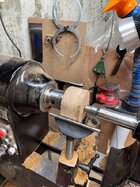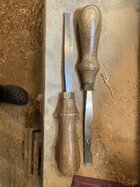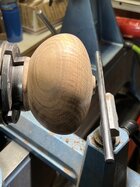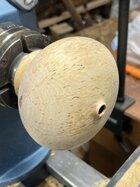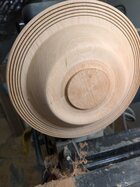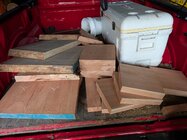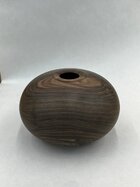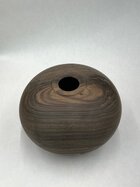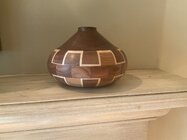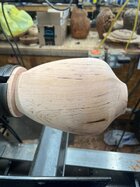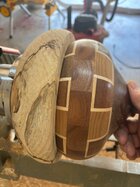Hmm... Wenge? Ziricote?Mystery wood - it’s about 6.5” x 4.5”
-
December 2025 Turning Challenge: Single Tree! (click here for details) -
Congratulations to Bob Henrickson, People's Choice in the November 2025 Turning Challenge (click here for details) -
Congratulations to Steven Gordon for "Dropped Ice Cream Cone" being selected as Turning of the Week for December 8, 2025 (click here for details) -
Welcome new registering member. Your username must be your real First and Last name (for example: John Doe). "Screen names" and "handles" are not allowed and your registration will be deleted if you don't use your real name. Also, do not use all caps nor all lower case.
You are using an out of date browser. It may not display this or other websites correctly.
You should upgrade or use an alternative browser.
You should upgrade or use an alternative browser.
What’s on your lathe?
- Thread starter Rusty Nesmith
- Start date
African Blackwood pedestal ... I can't say that I actually like turning blackwood,
WHAT?!! Just stick to what you like and send all that nasty Af. Blackwood to me. I love it.
JKJ
@John Redding Re: Mystery wood
Many species can look similar.
Did that come from a local tree or from some unknown tropical country?
Have any bark, or better, leaves?
Does the wood have a distinctive smell?
Does it fluoresce under UV light (if you have one)?
Look at the end grain with a magnifier - is it ring porous, diffuse, or semi-difuse porous?
Are the earlywood pores filled with tyloses? Large?
Do the latewood pores have a distinctive pattern?
Are the rays prominent without a magnifier?
If you still have an offcut cut a rectangular or square piece, calculate the volume, weigh with gram scale, and determine the density.
These are some of the things that can help narrow down the species, or at least, eliminate some.
The identifying wood article on the Wood Dataabase web site has info, including how to get a free ID from the gov lab.
Many species can look similar.
Did that come from a local tree or from some unknown tropical country?
Have any bark, or better, leaves?
Does the wood have a distinctive smell?
Does it fluoresce under UV light (if you have one)?
Look at the end grain with a magnifier - is it ring porous, diffuse, or semi-difuse porous?
Are the earlywood pores filled with tyloses? Large?
Do the latewood pores have a distinctive pattern?
Are the rays prominent without a magnifier?
If you still have an offcut cut a rectangular or square piece, calculate the volume, weigh with gram scale, and determine the density.
These are some of the things that can help narrow down the species, or at least, eliminate some.
The identifying wood article on the Wood Dataabase web site has info, including how to get a free ID from the gov lab.
While I live in Charlotte, this piece is one of dozens of turning blanks that I picked up when my FIL passed. He collected kinds of wood from anywhere he could as long as he thought it was interesting, though he didn’t always label it. This one was covered in wax, so my guess is tropical from a retail store and could have been in his shop for years. I’ll have to do a bit of investigating.
While I live in Charlotte, this piece is one of dozens of turning blanks that I picked up when my FIL passed. He collected kinds of wood from anywhere he could as long as he thought it was interesting, though he didn’t always label it. This one was covered in wax, so my guess is tropical from a retail store and could have been in his shop for years. I’ll have to do a bit of investigating.
Could be anything then! Wish I could drive over and take a look. Save any offcuts, even if small.
- Joined
- Nov 27, 2021
- Messages
- 241
- Likes
- 999
- Location
- Silver Spring, MD
- Website
- www.transpirationturning.com
Channeling some @Pat Wisniewski today on this bit of American elm. The interior support rings are a continuous spiral, though I wish I would have continued it all the way to middle. Now for some (lots) of cleanup.
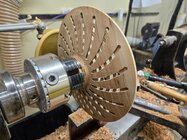
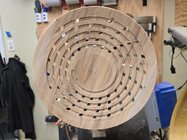


The aforementioned woodturner who is looking to have a sale stopped by yesterday and gave me some 20tpi chasers, brass, and some mesquite for handles. I made some handles and tried threading. I have never done anything of the sort, and there is definitely nothing else like it. The first try was quina which has terrible interlocked grain, and large pores. The second is mountain mahogany. It was late when I got to it, so I was a little rushed. I found a ring that I had made of MM, so i tried the internal thread. My speed was about 200rpm, I don’t have the hook arm tool, tried using some paragon for lubricating, didn’t really do anything. I don’t think the MM is threaded deep enough, the threads are flat. If anyone has any suggestions, I'm open.
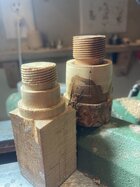
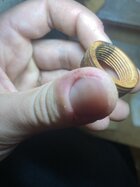
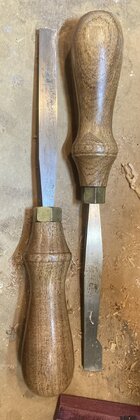



Attachments
Those are really good threads for the first time and especially using 20 tpi, Great!
- Joined
- Feb 28, 2021
- Messages
- 1,770
- Likes
- 1,582
- Location
- Roulette, PA
- Website
- www.reallyruralwoodworks.com
yeah what bill said - Also, you don't WANT pointy threads on wood threaded stuff - sharp points are too fragile - flatter threads are much stronger (and if you look close, even metal screw threads are relatively flat or at least rounded over - no sharp edges - unless freshly cut by a tap or die...and those are often wire brushed to remove the sharp edges) I did my first threads at 16 TPI to make a box - threads came out nicely, but the fit left a bit to be desired... (the real challenge is getting a matching set of male & female threads! Cutting them is relatively easy.)
A friend had a large oak come down and asked if I would make a bowl for her. She brought over a couple of pieces and I'm fairly sure that it is white oak. I roughed out a couple of traditional and natural edge bowls to provide some choices.
Edit: I asked and it is Red Oak
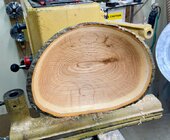
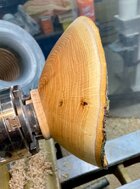
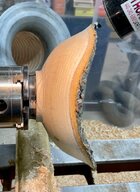
This wood is definitely hard! Then there is the one thing that I don't particularly care for is the amount of tannin in oak!
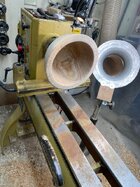
I use a scotch brite pad and WD40 to clean it up and then coat the ways with Ballistol oil.
Edit: I asked and it is Red Oak



This wood is definitely hard! Then there is the one thing that I don't particularly care for is the amount of tannin in oak!

I use a scotch brite pad and WD40 to clean it up and then coat the ways with Ballistol oil.
Last edited:
She brought over a couple of pieces and I'm fairly sure that it is white oak.
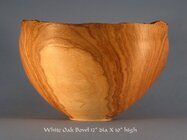
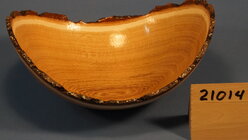
The bowl on the left is white oak with a natural edge being the split near a large crotch made in 2003. The bowl on the right is red oak with the bark including likens natural edge made in 2021. The bark on the two families of oak are very different and likens don't appear to grow on the white at least in my neck of the woods. The leaves of the white have rounded lobes, where as the reds have sharp points, so if that tree recently came down you should be able to find some old leaves.
Been a little stressed with a hollow form I’m doing some carving and pyro on so I walked away from it for a while and decided turning a basic bowl would help release the stress and I even used the bottom bow gouge ! Found a piece of maple that I had wrapped up and decided to turn a natural edge since it was cut in the winter. Should finish out 12” x 8-9”.
! Found a piece of maple that I had wrapped up and decided to turn a natural edge since it was cut in the winter. Should finish out 12” x 8-9”.

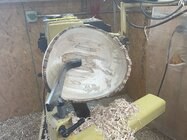




Kevin Jesequel
TOTW Team
Wow that Masur Birch looks smooth! Really nice figure too.Black acacia from last night
View attachment 76092
And Masur Birch from this morning
View attachment 76093
My sister thought I needed to make some basket illusion plates/platter. She gets to color I guess so I'm taking it easy for the first one. I told her I'm going to need some wood so we went to the wood guy and that's the result.
Attachments
Paul,Channeling some @Pat Wisniewski today on this bit of American elm. The interior support rings are a continuous spiral, though I wish I would have continued it all the way to middle. Now for some (lots) of cleanup.
We are not that far away from one another. I am quite intrigued with what you are doing.
I’d like to visit and see how you do your magic. And it’d be great to host you here for a day, too.
And yes, the cleanup, filing, sanding takes as long or longer than creating the pieces!
To help with the clean up you could try using a down cut router bit that would eliminate a lot of the edge fusizesChanneling some @Pat Wisniewski today on this bit of American elm. The interior support rings are a continuous spiral, though I wish I would have continued it all the way to middle. Now for some (lots) of cleanup.
View attachment 76055
View attachment 76056
- Joined
- Nov 27, 2021
- Messages
- 241
- Likes
- 999
- Location
- Silver Spring, MD
- Website
- www.transpirationturning.com
On one of my earlier attempts I tried a compression bit and I didn't really find all that great an improvement and actually got more burning than I did with the upcut (though that could have been related to some slight hardware problems).To help with the clean up you could try using a down cut router bit that would eliminate a lot of the edge fusizes
I have downcut bits in a few sizes, but not the 1/4".
Stunning! Curious what the wood is!Finished the mystery wood hollow form and forgot to take a picture before parting off. I did save a small offcut and will attempt to identify. This one is now 6.5” wide x 4” deep and 3/16” thick.
One little tip with the bowl. When it is done you don’t want anybody to know how it was held on the lathe. It would be easy to turn the mortise into a foot.
That's one opinion. I often leave a recess in the bottom for both efficiency and design reasons.
Turners and non-turners alike have had no problems with it, in fact, people often turn the piece over and make little surprised and pleased sounds.
I like to add detail to the foot and inside the recess; try to make them all unique.
One little tip: a shallow flat-bottomed recess groove makes a great little "shadow box" effect for the signature.
Some examples: sapele, goncolo alves, maple

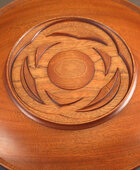
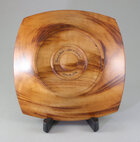

In all of these I left the the holding recess. Some are less than an 1/8" deep, some more for design reasons.
The recess on the big off-axis platter is just the inside of the three little sort-of triangle shapes. All held well.
My opinion: the first rule of art is there are no rules.
JKJ
I agree John. Yours does not look like a plain mortise and with all of the detail added the normal person would never know. I ran across one of my first pieces in the house. I turned it over and saw just a plain mortise and could only stand there a cringe.
On my lathe, or rather was on my lathe.
Or rather was on my Jet1642 lathe until I gave the lathe to a good friend recently. (Is that cheating here?)
He turned a lot of things 45 years ago on a Rockwell-Delta Reeves drive lathe but quit for decades.
I was thrilled when he started turning again with my "old" lathe, and made this for me from a blank I gave him long ago in an attempt to spur him into action.
Looks like he didn't forget how.
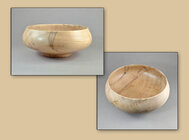
It's about 11" wide, 5.5" high. Turned on a faceplate with screws, then the flat bottom back on the face plate but held with double-sided tape to turn the inside. That's the method he had always used "back in the day", even with quite large pieces turned outboard. He's an accomplished potter and has a good eye for form. Better than me.
His next bowl from Canary wood was started again with the faceplate and screws. Then I sent him home with a chuck and instructions on how to make a recess.
Hopefully there will be a lot more things come off that lathe I used in my shop for over 20 years!
Next task is to get to sign up for the AAW forum!
Coming to my shop in a few days for something entirely new - a skew lesson!
JKJ
Or rather was on my Jet1642 lathe until I gave the lathe to a good friend recently. (Is that cheating here?)
He turned a lot of things 45 years ago on a Rockwell-Delta Reeves drive lathe but quit for decades.
I was thrilled when he started turning again with my "old" lathe, and made this for me from a blank I gave him long ago in an attempt to spur him into action.
Looks like he didn't forget how.

It's about 11" wide, 5.5" high. Turned on a faceplate with screws, then the flat bottom back on the face plate but held with double-sided tape to turn the inside. That's the method he had always used "back in the day", even with quite large pieces turned outboard. He's an accomplished potter and has a good eye for form. Better than me.
His next bowl from Canary wood was started again with the faceplate and screws. Then I sent him home with a chuck and instructions on how to make a recess.
Hopefully there will be a lot more things come off that lathe I used in my shop for over 20 years!
Next task is to get to sign up for the AAW forum!
Coming to my shop in a few days for something entirely new - a skew lesson!
JKJ
Last edited:
I didn’t like the long neck on my hollow form I entered in the challenge so off it came. Maybe i can start a bowl that would be a jam chuck and turn a dowel tenon so i can turn it and put a new bead and curve on top. It definitely looks better than that tall thing.
Attachments
Last edited:
I agree John. Yours does not look like a plain mortise and with all of the detail added the normal person would never know. I ran across one of my first pieces in the house. I turned it over and saw just a plain mortise and could only stand there a cringe.
Maybe use a spiral or star wheel texturing tool and make something to glue in the hole. Color optional.
From part of a texturing demo I did in 2016.
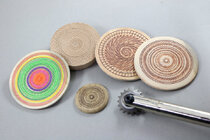
In fact, with a spiraling tool you sometimes only get one chance for something to look good, lots of chances to look bad. For The top of box lids I think it's better to turn pieces like this, then when satisfied with one glue it into a recess in the top of the box lid. Can taper both pieces a tiny bit for a snug fit in a straight-sided recess.
JKJ
Last edited:
These pics were in the challenge entry thread but I'm hoping it's not against the law to put them in this "what's on" thread.
This was on my lathe just over a week ago, done at the last minute for the challenge. I was recovering from surgery, finally off the pain meds and started feeling better so I thought, why not, I'll try to scratch out something for the monthly challenge, my first ever I think. Good fun!
I've made plenty of lidded boxes and some long-necked pieces but never combined them. It was a bit of a challenge to figure out how hold the various pieces and turn for the precision needed and what to do in what order. I ended up using multiple chucks and a custom live center point PLUS added support to a too-thin neck. (Mistakes were made.)
The piece is not very practical as a box but perhaps may be a clue to the answer of the age-old question, "How did they ever get that genie into the bottle the first time?"
Made from a Persimmon blank dried for 6 years, very hard, fantastic to turn. Turns like ebony. Oh wait, it IS ebony! "White ebony / American ebony"
Insides smoothed with small, curved hand scrapers and a bit of hand sanding. "Danish" oil finish inside and out - didn't have enough time for my usual procedure so I applied and wiped off several coats over 24 hours. Beall buffed and bit of Renaissance Wax over the oil.
(The lighter ring you can see at the widest diameter is just the way the light caught it the grain - not visible at other angles.)
The stopper is transparent blue acrylic - odd shapes of acrylic can be challenging to hold, easy to turn, very easy to sand and polish.
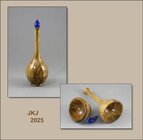
When I get time I hope to do a short write-up with the sketches I used to plan the form and process, some in-progress photos. and a bit about what I learned not to do. And maybe something about working with cast acrylic.
And maybe something about working with cast acrylic.
If anyone close wants a piece of dry Persimmon to play with, stop and visit - I've got a little left. Oh, I forgot, anyone in this part of the country probably already has plenty of Persimmon! I once counted maybe 40 on my property, recently took down 4 or 5, and more need to come down. We have both the female and male trees. Bring a chain saw - it's fun to turn green too. Fine grained and slow drying time. Persimmon is mostly sapwood with a jet black pencil-thin heart wood. If cut in the middle of the winter it is sometimes white. Tends to get big grubs under the bark if a log is left on the ground.
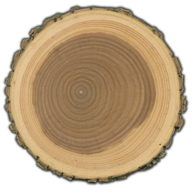 www.wood-database.com
www.wood-database.com
Rarely, you can find a piece where the black heartwood flares out into the sapwood in places. I kiss the ground when I find that.
Some other variations I've found in Persimmon.
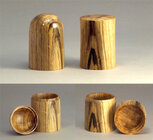
JKJ
This was on my lathe just over a week ago, done at the last minute for the challenge. I was recovering from surgery, finally off the pain meds and started feeling better so I thought, why not, I'll try to scratch out something for the monthly challenge, my first ever I think. Good fun!
I've made plenty of lidded boxes and some long-necked pieces but never combined them. It was a bit of a challenge to figure out how hold the various pieces and turn for the precision needed and what to do in what order. I ended up using multiple chucks and a custom live center point PLUS added support to a too-thin neck. (Mistakes were made.)
The piece is not very practical as a box but perhaps may be a clue to the answer of the age-old question, "How did they ever get that genie into the bottle the first time?"
Made from a Persimmon blank dried for 6 years, very hard, fantastic to turn. Turns like ebony. Oh wait, it IS ebony! "White ebony / American ebony"
Insides smoothed with small, curved hand scrapers and a bit of hand sanding. "Danish" oil finish inside and out - didn't have enough time for my usual procedure so I applied and wiped off several coats over 24 hours. Beall buffed and bit of Renaissance Wax over the oil.
(The lighter ring you can see at the widest diameter is just the way the light caught it the grain - not visible at other angles.)
The stopper is transparent blue acrylic - odd shapes of acrylic can be challenging to hold, easy to turn, very easy to sand and polish.

When I get time I hope to do a short write-up with the sketches I used to plan the form and process, some in-progress photos. and a bit about what I learned not to do.
If anyone close wants a piece of dry Persimmon to play with, stop and visit - I've got a little left. Oh, I forgot, anyone in this part of the country probably already has plenty of Persimmon! I once counted maybe 40 on my property, recently took down 4 or 5, and more need to come down. We have both the female and male trees. Bring a chain saw - it's fun to turn green too. Fine grained and slow drying time. Persimmon is mostly sapwood with a jet black pencil-thin heart wood. If cut in the middle of the winter it is sometimes white. Tends to get big grubs under the bark if a log is left on the ground.
Persimmon | The Wood Database (Hardwood)
Rarely, you can find a piece where the black heartwood flares out into the sapwood in places. I kiss the ground when I find that.
Some other variations I've found in Persimmon.

JKJ
These pics were in the challenge entry thread but I'm hoping it's not against the law to put them in this "what's on" thread.
This was on my lathe just over a week ago, done at the last minute for the challenge. I was recovering from surgery, finally off the pain meds and started feeling better so I thought, why not, I'll try to scratch out something for the monthly challenge, my first ever I think. Good fun!
I've made plenty of lidded boxes and some long-necked pieces but never combined them. It was a bit of a challenge to figure out how hold the various pieces and turn for the precision needed and what to do in what order. I ended up using multiple chucks and a custom live center point PLUS added support to a too-thin neck. (Mistakes were made.)
The piece is not very practical as a box but perhaps may be a clue to the answer of the age-old question, "How did they ever get that genie into the bottle the first time?"
Made from a Persimmon blank dried for 6 years, very hard, fantastic to turn. Turns like ebony. Oh wait, it IS ebony! "White ebony / American ebony"
Insides smoothed with small, curved hand scrapers and a bit of hand sanding. "Danish" oil finish inside and out - didn't have enough time for my usual procedure so I applied and wiped off several coats over 24 hours. Beall buffed and bit of Renaissance Wax over the oil.
(The lighter ring you can see at the widest diameter is just the way the light caught it the grain - not visible at other angles.)
The stopper is transparent blue acrylic - odd shapes of acrylic can be challenging to hold, easy to turn, very easy to sand and polish.
View attachment 76161
When I get time I hope to do a short write-up with the sketches I used to plan the form and process, some in-progress photos. and a bit about what I learned not to do.And maybe something about working with cast acrylic.
If anyone close wants a piece of dry Persimmon to play with, stop and visit - I've got a little left. Oh, I forgot, anyone in this part of the country probably already has plenty of Persimmon! I once counted maybe 40 on my property, recently took down 4 or 5, and more need to come down. We have both the female and male trees. Bring a chain saw - it's fun to turn green too. Fine grained and slow drying time. Persimmon is mostly sapwood with a jet black pencil-thin heart wood. If cut in the middle of the winter it is sometimes white. Tends to get big grubs under the bark if a log is left on the ground.
Persimmon | The Wood Database (Hardwood)
www.wood-database.com
Rarely, you can find a piece where the black heartwood flares out into the sapwood in places. I kiss the ground when I find that.
Some other variations I've found in Persimmon.
View attachment 76162
JKJ
Agree!
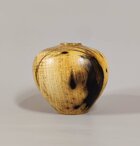
Fresh piece of cherry.
After seeing some of your other pieces I can't wait to see what you'll do with that. Maybe post both the before, in progress, and after pictures then!
I didn’t like the long neck on my hollow form I entered in the challenge so off it came. Maybe i can start a bowl that would be a jam chuck and turn a dowel tenon so i can turn it and put a new bead and curve on top. It definitely looks better than that tall thing.
Very nice! Love that pattern. I think it looks excellent in this form.
@John Redding Re: Mystery wood
Many species can look similar.
Did that come from a local tree or from some unknown tropical country?
Have any bark, or better, leaves?
Does the wood have a distinctive smell?
Does it fluoresce under UV light (if you have one)?
Look at the end grain with a magnifier - is it ring porous, diffuse, or semi-difuse porous?
Are the earlywood pores filled with tyloses? Large?
Do the latewood pores have a distinctive pattern?
Are the rays prominent without a magnifier?
If you still have an offcut cut a rectangular or square piece, calculate the volume, weigh with gram scale, and determine the density.
These are some of the things that can help narrow down the species, or at least, eliminate some.
The identifying wood article on the Wood Dataabase web site has info, including how to get a free ID from the gov lab.
The mystery of my “mystery wood” has been solved. Went to the largest exotic lumber dealer in the area (West Penn Hardwoods) with a small piece from parting off and they immediately knew what it was - Cordia subcordata, also known as Kou. It’s a wood indigenous to Hawaii. They also had some, so I bought three 6x6x4 pieces just because I liked it.
I’m about 30 minutes from West Penn and bought a couple of burl caps from them. Did they have more of the Kou?The mystery of my “mystery wood” has been solved. Went to the largest exotic lumber dealer in the area (West Penn Hardwoods) with a small piece from parting off and they immediately knew what it was - Cordia subcordata, also known as Kou. It’s a wood indigenous to Hawaii. They also had some, so I bought three 6x6x4 pieces just because I liked it.
David - They do have quite a bit and apparently it’s pronounced “koo”. If you go in through the office it’s the second or third row in, all the way down on the right (toward the lumber area) and on the right side of the aisle (facing the lumber area). It’s about an hour from me, so I also stopped at Klingspor for some sand discs I’ve been putting off ordering. John
Working on a 3 piece walnut cake stand. Will buy a glass one a Canadian Tire and likely throw away the glass bottom of it in order to use the glass dome. It’s cheaper to buy a complete glass stand rather than buying just the dome on Amazon. There might be a small opening where the top of the crotch is. However, in my home the cake will be long gone before it goes stale!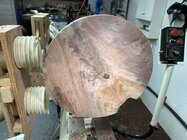

I’ll go by and check it out in the next week or two as I need to stop at Klingspor.David - They do have quite a bit and apparently it’s pronounced “koo”. If you go in through the office it’s the second or third row in, all the way down on the right (toward the lumber area) and on the right side of the aisle (facing the lumber area). It’s about an hour from me, so I also stopped at Klingspor for some sand discs I’ve been putting off ordering. John
Michael, I have worked canary wood a couple of times, though it has been a while. That would be last guess for what you are showing. Colors just look wrong. Some thing else?
robo hippy
robo hippy

